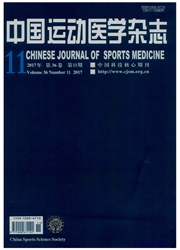

 中文摘要:
中文摘要:
目的:观察运动疲劳前后大脑基底神经节纹状体1H谱物质的变化,寻找反映运动性中枢疲劳的特征物质。方法:采用磁共振氢谱检查技术,检测6名男性大学生在一次性递增负荷功率自行车运动前后脑内纹状体区域氮-乙酰天门冬氨酸(NAA)、胆碱复合物(Cho)、肌醇(mI)、α-氨基酸(α-Glx)、乳酸(Lac)以及肌酸(Cr)的含量变化并对其进行比较分析。结果:运动疲劳前后发生显著变化的特征物质包括NAA、α-Glx和Lac,其中NAA/Cr峰高较运动前显著降低(P〈0.05);α-Glx/Cr峰高较运动前显著增高(P〈0.05);Lac/Cr峰面积较运动前显著增加(P〈0.05)。结论:运动疲劳后大脑纹状体NAA、α-Glx以及Lac水平发生变化,提示其可考虑作为运动性中枢疲劳临床诊断的参考物质。
 英文摘要:
英文摘要:
Objective To observe the changes in 1HMRS spectrum in striatum of the basal ganglia in order to look for the sensitive indicators of exercise-induced fatigue.Methods Magnetic resonance spectroscopy was applied to observe six male college students before and after cycling exercise with incremental intensity.Results NAA/Cr decreased significantly after exercise-induced fatigue(P 0.05);α-Glx/Cr increased significantly(P 0.05);and Lac/Cr increased significantly(P 0.05).Conclusion NAA,α-Glx and Lac levels change significantly after exercise-induced fatigue,and thus they probably can be used as clinical diagnostic parameters.
 同期刊论文项目
同期刊论文项目
 同项目期刊论文
同项目期刊论文
 期刊信息
期刊信息
